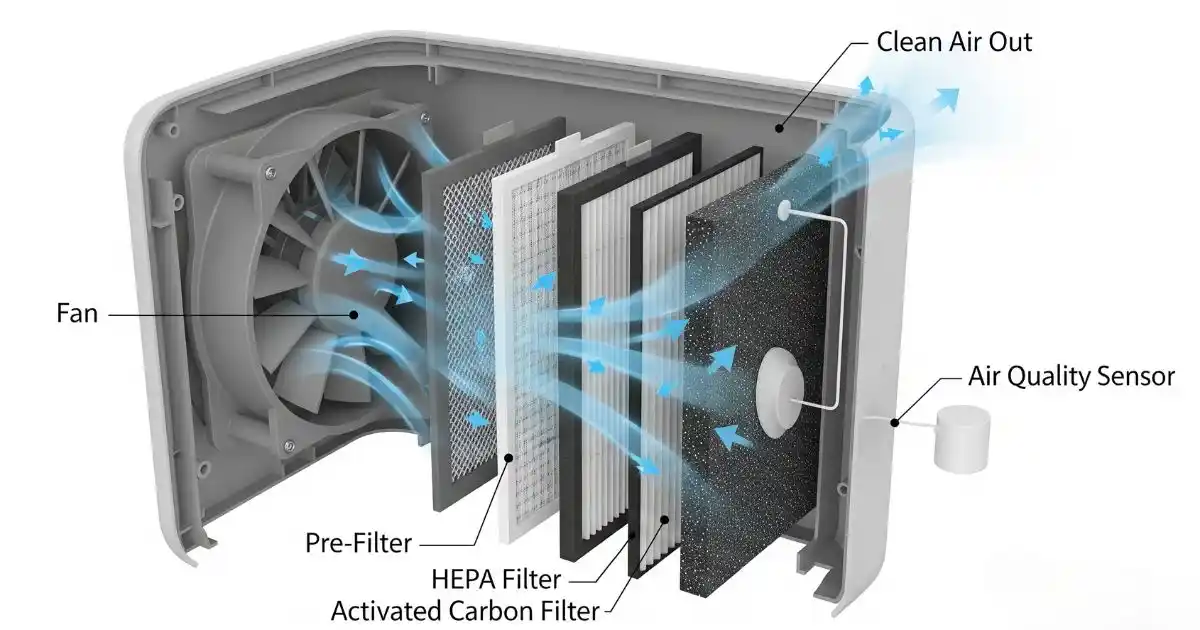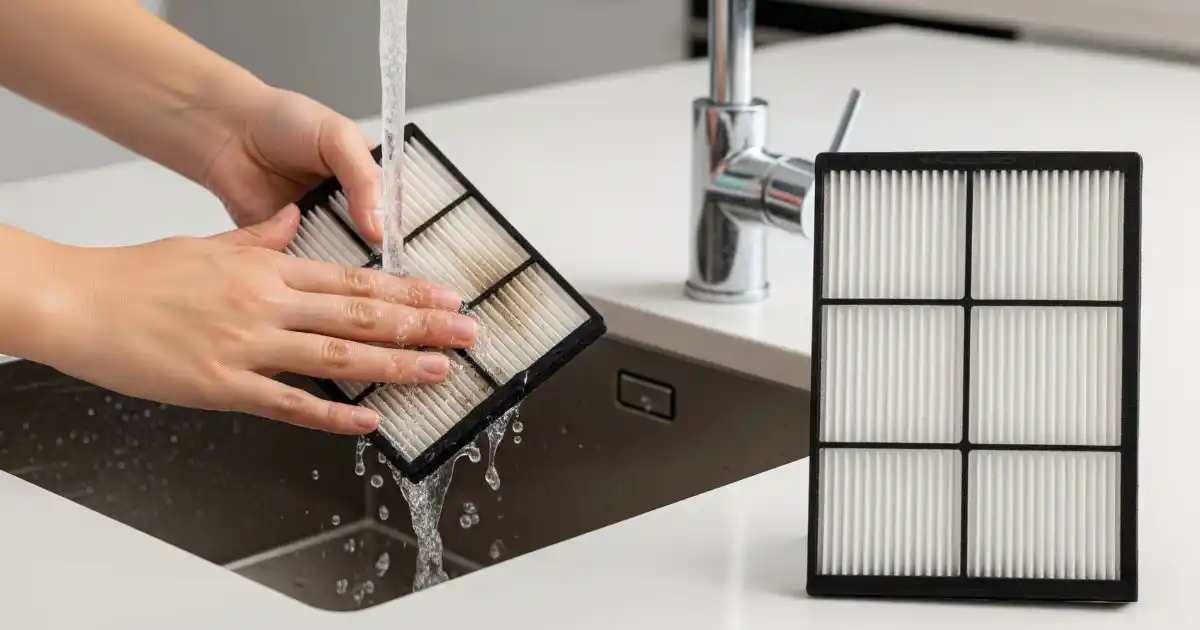Clean indoor air is more important than most people realize. Every day, we breathe in invisible particles like dust, pet dander, pollen, smoke, and even microscopic mold spores. Over time, these pollutants can trigger allergies, worsen asthma, and disrupt sleep.
That’s why air purifiers are becoming a must-have in many homes. These devices are designed to capture harmful particles, neutralize odors, and create a fresher, healthier living environment for you and your family.
If you want the best results, whether it’s reducing allergens, removing smoke, or simply enjoying cleaner air, choosing the best air purifier for your space is the first step toward better breathing and overall wellness.

Quick Navigation & Previews
How Air Purifiers Work
If you’ve ever wondered how does an air purifier work, the answer is simple: it pulls in your home’s air, passes it through multiple filters, and releases it back cleaner and healthier. This process reduces dust, pollen, smoke, pet dander, and other invisible particles that can impact your health.
Most air purifiers include three core parts:
- A fan – draws air into the unit and circulates it through the filters.
- Filters – trap pollutants, odors, and microscopic particles.
- Sensors – monitor air quality and adjust performance automatically in advanced models.
The HEPA filter is the gold standard, capturing up to 99.97% of particles as small as 0.3 microns, including allergens like pollen, dust, and even bacteria. Many purifiers also feature activated carbon filters to remove odors and harmful gases (VOCs) released from cleaning products, paints, or furniture.
Some models go further, adding UV-C light to neutralize airborne germs or water-based filtration that traps particles in water before releasing fresh air. Understanding the technology behind air purifiers helps you choose a model that meets your exact needs—whether it’s controlling pet hair, removing smoke, or filtering city pollution.
For peak performance, make sure you change your air purifier filter regularly. A dirty filter can’t trap particles effectively, making the purifier work harder and less efficiently. Many devices have a filter change indicator, often shown as a red button, to alert you when it’s time.
A common question is, “Do air purifiers make the air dry?” The answer is no, they don’t remove moisture. Similarly, “Does an air purifier help with humidity?” is also no. These devices clean the air, not control humidity levels. If moisture balance is important, pair your purifier with a humidifier or dehumidifier.
By knowing exactly how an air purifier works and keeping it maintained you can enjoy fresher air, fewer allergens, and a healthier home every day.

Where to Put an Air Purifier for Best Results
Knowing where to place an air purifier is just as important as choosing the right one. Even the best device won’t work well if it’s in the wrong spot. Proper placement ensures better airflow, faster purification, and maximum health benefits.
Here are some proven tips for optimal placement:
- Best place to place air purifier – Position it in the room where you spend most of your time, such as the bedroom for night use or the living room during the day.
- Where should I put my air purifier – Place it near sources of pollutants, like pet beds, near open windows during pollen season, or close to the kitchen if cooking odors are an issue.
- Avoid obstacles – Keep it at least 1–2 feet away from walls or furniture to allow air to circulate freely.
- Should an air purifier be on the floor? – While some purifiers are designed for floor placement, most work better when elevated on a table or stand, especially in larger rooms. Elevation helps capture airborne particles before they settle on surfaces.
If you have a small room, placing the purifier in the center can allow even air distribution. In larger rooms, position it closer to where you spend the most time rather than tucked into a corner.
Correct placement can make the difference between just running an air purifier and truly purifying home air for better breathing, reduced allergens, and fresher living spaces.
How Long Should You Run an Air Purifier
If you’re asking “How long should I run my air purifier?”, the answer depends on your indoor air quality, the size of the room, and the purifier’s capacity.
For most households, running an air purifier 8–12 hours daily is enough to maintain fresh, clean air. However, if you live in an area with high pollution, pollen season, or have allergies/asthma, experts recommend running it 24/7 for maximum health benefits.
Why keep it on longer?
- Reduces dust, pet dander, and allergens continuously.
- Maintains better air quality for sensitive individuals.
- Prevents pollutant buildup during peak hours.
Most modern air purifiers are energy-efficient and designed for continuous use, meaning you can safely keep them running without worrying about high electricity bills. You might only switch it off when:
- You need complete silence (some units make low-level noise).
- You’re away from home for extended periods.

Air Purifier Maintenance: What You Need to Know
An air purifier can only keep your air clean if it’s well-maintained. Without proper care, even the best device will lose efficiency, waste energy, and fail to protect you from pollutants.
- Replace Filters on Time
Most HEPA filters need replacing every 3–6 months (check your manufacturer’s guide for exact timing). Delaying this can cause:
- Reduced airflow
- Lower filtration efficiency
- More allergens and dust circulating indoors
- Watch for Signs It’s Time to Change
Don’t just rely on the calendar—look for warning signs:
- Reduced airflow from the purifier
- Unusual smells coming from the unit
- Filter-change indicator light (often red) turning on
- Know Your Filter Type
Some models have permanent, washable filters instead of disposable ones. Washing these regularly saves money on replacements and keeps performance high. Always follow the cleaning method recommended in your purifier’s manual.
- Troubleshoot Common Issues
- Noise problems? Check if the filter is clogged or the fan blades are dusty.
- High filter cost? Consider bulk-buying compatible filters or washable options.
Why Maintenance Matters
Proper maintenance not only extends your purifier’s lifespan but also ensures it removes pollutants effectively, lowers electricity costs, and keeps your home healthier. A neglected purifier can become a source of bad odors and even recirculate dust.
Air Purifiers & Humidity: The Facts
Many people confuse air purifiers with humidifiers, but they serve completely different purposes.
Air purifiers are designed to remove airborne particles like dust, pollen, pet dander, smoke, and allergens—they do not add or remove moisture from the air.
Does an Air Purifier Help with Humidity?
No. Air purifiers cannot control humidity levels. If you need to increase or decrease moisture indoors, you’ll need a humidifier (to add moisture) or a dehumidifier (to remove excess moisture).
Do Air Purifiers Make the Air Dry?
This is a common myth. Any dryness you feel is usually caused by indoor heating, air conditioning, or naturally low humidity, not the purifier itself. Air purifiers only circulate and filter the air; they don’t change its moisture content.
Best Way to Balance Comfort
If maintaining comfortable humidity is important for you:
- Pair your air purifier with a humidifier in dry seasons.
- Use a dehumidifier if your home feels damp or musty.
- Monitor indoor humidity with a hygrometer (ideal comfort range is 40–60%).
FAQs
Do air purifiers create ozone?
Ionic air purifiers and ozone generators can produce trace amounts of ozone; HEPA and carbon filter models do not.
What does CADR mean on an air purifier?
CADR stands for Clean Air Delivery Rate and measures how quickly an air purifier cleans a room of specific particles.
Are air purifiers noisy?
While most modern purifiers are quiet, some can produce a low-level fan noise, especially on higher settings.
Can I use an air purifier with a window open?
Yes, but it’s not recommended; for best results, run your purifier in a closed room so it can filter the air more effectively.
How do I know what size air purifier to buy?
Match the purifier’s recommended coverage area (in square feet) to the size of the room you plan to use it in.
Are permanent filters better than disposable ones?
Permanent filters save on replacement costs, but you must clean them regularly to maintain the purifier’s performance.
Conclusion
A quality air purifier can ease allergy symptoms, remove odors from cooking, pets, and smoke, improve sleep, and keep your home feeling fresh. Whether you’re battling seasonal allergies, city pollution, or simply want cleaner air, the right purifier can quickly enhance your comfort and overall well-being.
Leave a Reply